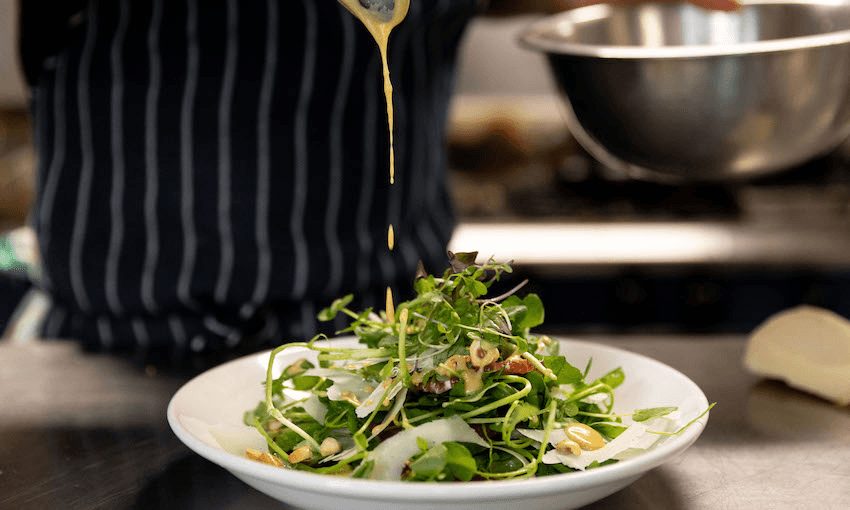Chef Luke Adams talks to Alice Neville about why cooking and eating with the seasons is so much more than a fad.
Like “artisanal”, “authentic” and “bespoke”, the word “seasonal” has become ubiquitous in descriptions of food – to the point that it’s almost lost all meaning.
That’s a shame, because eating seasonally is one of the easiest things you can do to become more connected to the source of your food. Plus it’ll taste better, you’ll save money and be helping the environment to boot.
For Luke Adams, head chef at L’affare Melrose in Newmarket, Auckland, eating and cooking with the seasons is a no-brainer. “It’s about eating what’s around at the time,” he says.
In recent months, that’s been gloriously fresh spring/summer produce — asparagus for Christmas and the arrival of affordable local eggplant, and herbs that are unique to the warmer months.
“Dill and tarragon really only become available midway through spring and they’re some of my favourite herbs. They’re very hard to get and never last so when they’re in, you eat them.”
At this time of year when he’s cooking at home, Adams (Te-Uri-o-Tai, Te Aupōuri) loves to barbecue veggies like zucchini and broccoli over charcoal embers and toss them through yoghurt with lemon and dill. At the cafe, a green goddess dressing featuring tarragon, dill, lime, coriander, parsley, basil and mint is used to dress several different lettuce varieties. The salad, served with spice-rubbed blackened free-range chicken thighs, has been a regular seasonal feature on the menu since L’affare Melrose opened a couple of years ago.
“Avocados are really good at the moment,” adds the chef. “I’d love to be able to take them off the menu when they’re $8 each and fibrous, stringy and pale. They taste like nothing, but people don’t care — if they want an avocado, they’ll eat it.”
Tomatoes are another thing people expect to have at their fingertips year round but are tastier — and cheaper — in the warmer months. “They’re definitely a lot better in season, mainly because they’re easily grown and easily ripened,” says Adams. “If you grow a tomato in a hot house in winter it will still grow, but it hasn’t naturally progressed. But a vine-ripened tomato that’s been outside all its life, ripening on the vine – that’s the way it’s meant to be.”
In this day and age, when we expect to have instant access to whatever we want, whenever we want, it can be hard to get your head around the idea of avoiding that shiny red capsicum calling to you from the veggie aisle in July, or even knowing what’s in season when. Adams says Google is your friend here – check out NZ-specific seasonal charts such as this one, this one, this one and this one.
Localness is of course entwined with seasonality, so keep that in the back of your mind. When the country of origin labelling regulations come in, it will be easier for consumers to know what’s local and in season, but there’s plenty you can do in the meantime to work it out. Many retailers already state the countries of origin of their fruit and veggies, and if not, a bit of knowledge around what’s in season when will help you figure it out. If you see a nectarine in the supermarket in July, for example, it’s a safe bet it’s not from anywhere round here.
Eating seasonally is an environmental decision too, and it’s worth remembering that local doesn’t automatically mean better. While the carbon footprint of bringing bananas from Ecuador, garlic from China and grapes from Chile to New Zealand is pretty obvious, the emissions produced by growing fruit and veggies in hot houses out of season are also substantial, even if that hot house is just down the road.
Eating produce only when it’s in season increases the enjoyment of it, too, says Adams – that excitement when the first bunches of asparagus appear, or consuming your weight in cherries at Christmastime because they’re such a rare treat. “I look forward to it,” he says. “It really sucks when my suppliers say ‘we’re out of dill’ or ‘we’re out of tarragon’.”
And at the end of summer, preserving the glut of produce is a clever way to get through the less abundant months. Towards the end of summer is a good time to start making kimchi or sauerkraut at home, says Adams.
“All the vegetables are old so it’s a perfect time to start preserving them for the winter. That whole mentality is quite cool – buying up heaps of shitty vegetables and turning them into something gold.”
This content was created in paid partnership with L’affare. Learn more about our partnerships here.
New members are always welcome at L’affare’s Avo Club. On Wednesdays (while they’re still in season), you’ll get avocado, chilli, pistachio and lime on toast, topped with a perfectly poached egg, for just $10.

